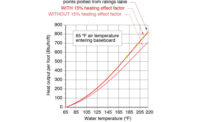Systems with remote condensers will generally require the installing technician to run the discharge line between the compressor and remote condenser. Just like the suction and liquid lines, proper sizing and installation practices need to be followed to ensure the system operates efficiently and reliably for many years.
Proper line sizing and installation techniques will allow the system to operate with acceptable pressure drops and sufficient oil movement through each line. Pressure drop in a discharge line is probably less critical than in any other part of the system. Generally, pressure drops up to 10 psi would not be greatly detrimental to system performance, provided the condenser is sized to maintain reasonable condensing pressures. Actually, a reasonable pressure drop in the discharge line is often desirable to reduce noise and vibration.
Because of the high temperatures existing in the discharge line, oil flows freely, and oil circulation through both horizontal and vertical lines can be maintained satisfactorily with reasonably low velocities. Although pressure drop and oil movement through discharge line is not as critical as in the suction or liquid lines, it still needs to be properly sized and piped to ensure the system operates efficiently and reliably, and good piping practices still need to be followed.
Always follow the manufacturer or industry piping guidelines for pipe size selection. The connection port sizes on either the compressor or condenser are not necessarily the right pipe size for an installation. Pipe size selection is based on several system criteria, including capacity, refrigerant type, design operating temperatures, and equivalent length of pipe. Undersizing the pipe can lead to an unacceptable pressure drop throughout the line, while oversizing could lead to insufficient refrigerant velocity to provide adequate oil movement through that section of the system.
On horizontal runs, pitch the pipe in the direction of flow at a slope of ½-inch per 10 feet. Vertical risers should be trapped at the bottom of all risers and trapped mid-run if greater than 20 feet in length to ensure adequate oil movement during low load conditions. An inverted trap should also be installed on the top of the riser. Oil traps are to be as short in radius as possible; common practice is to fabricate the trap using three elbows.
Oil movement in discharge lines may only be an issue on systems where large variations in system capacity are encountered. If at low load conditions the size of the discharge is too large to create the proper velocity to ensure the oil moves up the riser, a double riser may be employed to carry the oil up the riser at minimum load conditions. Also, if it is possible for the condenser to operate at a lower temperature than the receiver, a drain line check valve should be installed in the discharge line.
Remember, good sizing and piping practices should always be followed when installing any refrigeration system. Lack of following these general piping guidelines will result in either a failed compressor or a system not operating at its rated capacity.











